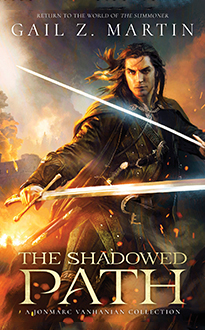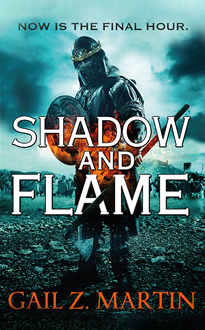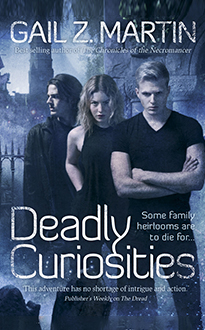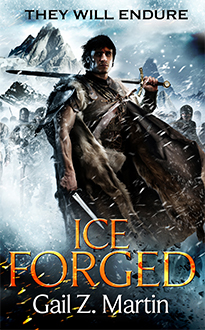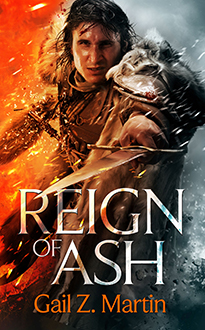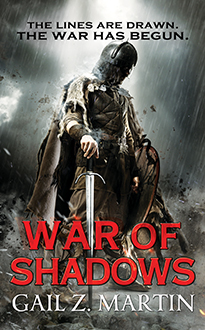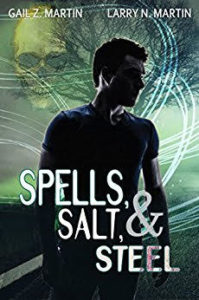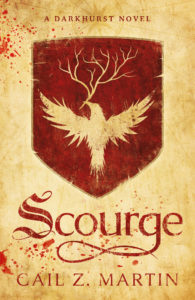 by James Maxey
by James Maxey
https://dragonprophet.blogspot.com/
So, I’m currently well past the halfway mark of the first draft of my tenth novel, Hush. When I started the book, I knew exactly how it began, since it starts just a week after my novel Greatshadow ends. At the end of that book, one of the surviving characters has made a vow to a dying friend to return a sacred weapon to a temple in a faraway homeland. The book starts with her gathering things she’ll need to make this trip. I also knew exactly how the book ends. The weapon needs to end up back in the hands of its rightful owners. So, I have a first chapter, that should be good for 5000 words. And I have a last chapter, good for another 5000 words. I’m under contract to turn in a novel approximately 110,000 words long. What the hell do I put into the middle 100,000 words?
I wish I could claim to have some systematic approach to logically filling in the giant gap between the beginning and the end of my books. My real approach is to just dive in and start making up stuff, then keep on making up stuff, then make up more stuff. So far, this approach has worked for me. But, somewhere around chapter 10 of Hush, I’d written two fight scenes back to back and I realized I couldn’t immediately use another fight scene. But, it was also too early just to have everyone settle down and talk about the weather for a chapter or two. What I needed, I thought, was a peril. I settled on the ship being damaged in the course of the last fight, and now it’s sinking. Once they saved the ship, there would be time for a talking scene. Then I’d throw in a big obstacle for my characters to get around. Then, it might be time for another fight. I realized as I was thinking through all the upcoming turns of events that I do have a few standard categories of events that my chapters follow. I don’t present these as formulas, but as a potentially useful tool for the next time you are writing a book and you’ve just had your characters jump out of the frying pan, escape the fire, and are now staring at a blank screen wondering, “Okay. Now what?”
1: Fights. Since I write action adventure fantasies, the first thing standing in my characters’ ways are ordinarily other characters. While in a perfect world they could resolve their differences with a friendly smile and a handshake, in my books someone almost always winds up throwing a punch. Fights tend to be inherently interesting, and I sprinkle them liberally throughout my books, but too much of a good thing gets tiresome. So, when even I’m tired of my characters fighting, it’s time for:
2: Perils. The ship is sinking! The building’s on fire! A tornado just picked up the house! Perils are obstacles that threaten the lives of the characters. They can’t be solved by punching someone. Perils are handy in their neutrality. The same hurricane that is dashing your ship against the rocks is also scuttling the zombie pirate ships that were chasing you. Or the evil space tyrant who was going to delight in torturing your heroes flees in his escape capsule as the space station gets too close to the black hole.
3: Barriers. What you need to succeed is someplace you ain’t, and getting to it won’t be easy. The medicine you need to halt the zombie plague is in a locked bunker in Antartica, and you’re on the side of the road in the Arizona desert with an empty gas tank and no bars on your cell phone. Or, maybe the floor plans you need to get past the bank’s security system are in a safe on the 99th floor, guarded by sharks with laser beams. Which leads to:
4: Puzzles. A subcategory of barriers. You’ve captured the Nazi attack plans, but they’re in code. What’s the key? They dying man’s last words were a cryptic quote from Shakespeare’s “Tempest.” What was he trying to tell you? Puzzles can sometimes be large enough to last an entire book, but if you scatter smaller ones throughout your plot they are useful in demonstrating that your hero has virtues other than tough fists and a heart of gold.
5: Tests. Not SAT type problems, but moral tests. The mob boss has just called your cop hero into a private meeting. Call off the investigation, turn over the hard drive with the evidence, and whoah, where did this suitcase full of hundred dollar bills come from? Or, the lead vampire has just pulled off her hood and, gasp, it’s your own mother! You aren’t going to stake your own mom, are you?
6: Annoyances. Of course, if every problem your character faced was some life altering choice or unstoppable foe, you’d burn out your readers pretty quickly. Sometimes it’s out of the frying pan, into the fire, then back into the %$#&! frying pan because the hero dropped his damn car keys. Other times, the good guy is just about to charge into the demon lord’s throne room when his kid sister taps him on the shoulder and asks what he’s doing. He was sure she’d been asleep when he slipped out the bedroom window!
7: Chats. No matter how gung ho your characters are, there are going to be scenes in your book where your characters do nothing but stand around and talk. Frequently, these scenes serve to advance the plot. After a fight, your heroes interrogate a captured guard and learns that the kidnapped princess is locked in the north tower. Now they talk through a plan on how to get her out. Later, they talk through what when wrong when they rescue not the princess, but her hairdresser. Stuff happens. People talk about it.
8: Respites and interludes. Finally, sometimes the world just gives you a break. Right in the middle of Greatshadow, I have a chapter where the characters meet the long lost grandfather of the narrator and are invited back to his jungle village to rest and recover from their wounds. The characters had just survived a long string of fights and perils, and it was a welcome break to have the characters sitting around debating philosophy while dining on an exotic jungle buffet of mystery fruits, raw snails, and katydids. I’ve made this a separate category from the previous one because other talking scenes can unfold while danger is imminent. With a respite, you and your readers can take a deep breath and relax for a moment and find out what your characters are like when they aren’t killing people. These peaceful scenes also help to establish a sense of what might be lost if Evil Triumphs.
Of course, all of these categories are amorphous, and frequently overlap in the course of a single scene. And despite the fact I’ve numbered them, I wouldn’t advise digging out your 8-sided dice from your D&D set and trying to plot a book by rolling random numbers. There’s an ebb and flow to these events that feels natural that you can only develop by actually writing. Still, if you do find yourself wondering “What comes next?” I hope this list helps jog your imagination.


